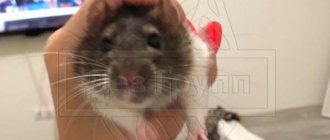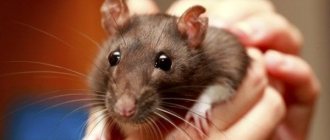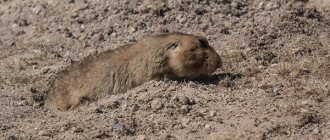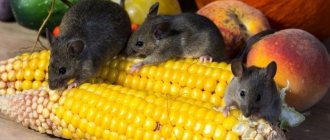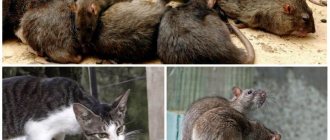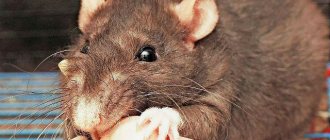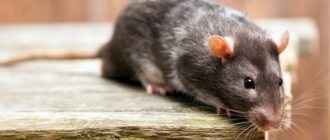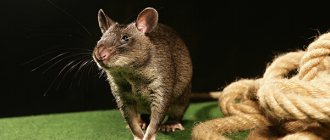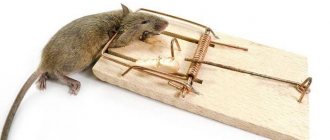Lifespan of decorative rats
Veterinarians claim that these rodents live 2-3 years.
Such indicators are possible if you properly care for your pet, maintain the correct diet, and regularly take the animal to the veterinarian. Of course, all this will extend the life of the rat and protect it from possible diseases. Proper care is also needed because ornamental species of rodents differ significantly from their wild counterparts in terms of endurance, and they have much weaker immunity. Therefore, you need to think seriously before getting such a pet for your child. If an adult can bear the death of an animal relatively calmly, then for children it will definitely be stressful.
The rat makes strange noises: what should I do?
Rats are usually silent creatures, but in some cases you may hear noise from your pet. When rats are babies they can be quite loud, but this completely stops as they grow up. Rodents can also make noise when playing, fighting, or in pain, but these are very recognizable high-pitched squeaks. Rats also make a unique yet pleasing sound when they grind their teeth to keep them sharp. Not only does this serve a practical purpose, but it is also a sign that they are happy.
If your rat makes any sounds other than these, there is cause for concern. They are susceptible to respiratory infections, and even a healthy rat can develop serious health problems. A proactive visit to a veterinarian experienced in rodent care will either confirm that your rat is healthy or provide it with the necessary treatment to live a long and fulfilling life.
Elimination of consequences
The body was thrown away, but the smell remained. This situation happens if the stench has been present in the room for a long time. Materials were saturated - paper, fabric, wood. You will have to carry out a whole range of measures to put the house in order.
- open windows, doors, make a draft in the room so that the stinking aroma disappears faster;
- put the torn board back in place;
- send curtains, bedspreads, napkins - all fabric products for washing;
- Apply cleaning agent to carpets and vacuum thoroughly;
- Sprinkle a thick layer of soda on the floor, it draws out the smell from the wood well - leave for 1-2 hours, vacuum;
- add chlorine or a detergent containing it to the water, wash the floor - whiteness is excellent;
- A special composition is prepared for processing furniture. Add 1 teaspoon of liquid soap and 50 g of soda to 0.95 liters of hydrogen peroxide. Mix thoroughly and pour into a spray bottle or spray bottle. Treat the hard surface of furniture. After 60 minutes, remove the composition with a damp cloth.
At the final stage, you need to use an air freshener.
Gets rid of the dead rat smell
Traditional methods of neutralizing the unpleasant odor of rats
Rats often die under the floor; people have come up with many ways to kill the smell or eliminate it completely after removing the body.
- Fire. Light a torch and walk around the room with it, especially in the room where there was a rat under the floor. Instead of a torch, you can use incense sticks.
- Vinegar. Moisten a cloth generously and leave for 10-12 hours. Ventilate the room well.
- Potassium permanganate. Prepare a solution, treat the floor, furniture, walls.
- Lavender. If the house smells strongly, the aroma of lavender can cover the smell. You can use a plant, air freshener, essential oils.
Anti-odor medications
Odor neutralizers deal with persistent stench. Eliminates the smell of urine and feces after animals. Used to eliminate the smell of a dead rat.
The preparations do not contain aggressive components that can damage furniture. Can be used on different surfaces, including the upholstered part of a sofa and armchairs. Unlike conventional cleaning agents, detergents provide quick, complete elimination of stench.
The product has no pungent odors, does not cause an allergic reaction, and does not emit toxins during evaporation. It is very convenient to use, since it is sold ready-made, with a sprayer.
The most common brands:
- Biolife Safe @ Clean, Germany;
- OdorGone, USA, lavender scent;
- Fridge Balls, South Korea, unscented.
You can use any air freshener or product designed to neutralize pet waste.
Age-related heart rate norms
In adults, a normal rhythm is considered to be about 60-70 beats per minute. Below or above these limits is a warning about abnormalities in the body. Doctors consider a slow heartbeat - bradycardia - to be a more dangerous phenomenon. Rapid pulse - tachycardia, when the brain experiences a lack of oxygen. It compensates for the deficiency in two ways: by increasing blood pressure or increasing heart rate. Their frequency depends not only on external factors and chronic diseases, but also on a person’s hereditary predispositions.
Average value (beats per minute)
Standard boundaries depend on a person’s age, but we must not forget about individual characteristics. Anything higher is an increased heart rate. An adult is diagnosed with tachycardia when his pulse exceeds 90 beats.
Posts 1 page 16 of 16
Share12012-08-21 15:07:38
- Author: Coma white
- Participant
- From: Sevastopol
- Registered: 2012-08-12
- Invitations: 0
- Posts: 50
- Female gender
- Time spent on the forum: 15 hours 39 minutes
- Last visit: 2012-08-28 10:52:32
Hello. The problem I have is this: yesterday I took an adult rat (a boy) from my friends; his age is unknown, since he has been wandering from hand to hand all his life. They kept him poorly, they fed him with something unknown, and the last owners even believed that the rat did not need water, instead of bedding with newspapers. In general, the trouble is that the rat looks healthy outwardly, the only bad thing is that it grunts, similar to the sounds that guinea pigs make, especially when it eats or sniffs something. In general, I can’t take him to the vet yet. the next couple of days, what can be done during this time?
The rat sneezes and itches
These symptoms are common for an allergic reaction or parasite infestation. Allergies can be caused by various factors:
- strong odors - perfumes, air fresheners, tobacco smoke;
- new food - may also contain allergens;
- filler components, hay;
- printing ink - if newspapers are used for bedding;
- household chemicals used to clean the cage.
When infected with fleas or lice eaters, the baby rat constantly itches, and the waste products of the parasites provoke allergic sneezing. If you find symptoms of parasite infection in your animal, you need to wash it with a special pet shampoo. If an allergy is suspected, it is necessary to exclude all possible irritants, change the filler and food, and give the rat vitamins.
Other causes of difficulty breathing
In addition to the listed main causes of heavy breathing with whistling, coughing and grunting, the following pathological conditions can lead to the appearance of similar symptoms:
- Low humidity in a room with a cage . The optimal figure is considered to be 50-60%. At lower values, the animal’s mucous membranes dry out and a lot of mucus forms in the nasal passages. The result is difficulty breathing with a characteristic gurgling sound.
- Deviation of the nasal septum . Such anatomical features are characteristic not only of humans, but also of animals. In this case, there is no way to get rid of noisy breathing. The main thing is to take the rat to a veterinary clinic and make sure that the problem is the curvature.
- If the condition deteriorates sharply, the animal suffocates and struggles in a fit, most likely the pet simply choked . In such a situation, you need to take the fluffy in your hands, fix the head (so that the neck does not dangle) and trot intensively. The stuck piece of food should pop out.
- ARVI . An animal with a cold usually coughs and sneezes intensely and breathes heavily. A rat can catch ARVI from a banal draft or hypothermia. Antibiotics and mucolytic drugs will help your pet against colds.
- Allergic reactions . When an animal has an allergy, it’s not just breathing problems that arise. Fluffy begins to itch intensely, the eyelids swell, and a small rash appears on the skin. Most often, rats are allergic to low-quality litter or food (citrus, red pepper, sweets). Therefore, to alleviate the animal’s condition, the first step is to eliminate the allergen. After which - give a couple of drops of an antihistamine - Fenistil, Dezal, Zodak.
Sometimes allergic reactions can develop into life-threatening conditions for the animal - Quincke's edema and anaphylactic shock. At the same time, the pet begins to fall, suffocate, greedily swallowing air through its mouth. As an emergency, you will need to inject your fluffy with Prednisolone in combination with Suprastin.
Why does a decorative rat have trouble breathing?
Wheezing in a rat, irregular breathing rhythm and the appearance of extraneous sounds when inhaling and exhaling indicate deadly heart or lung diseases in a domestic rodent, such as:
- Bronchitis;
- Pneumonia;
- Asthma;
- Mycoplasmosis;
- Heart failure;
- Heart attack or stroke;
- Neoplasms or abscesses in the lungs.
IMPORTANT. In domestic rats, against the background of increased metabolism, pathological processes develop rapidly; at home it is impossible to correctly diagnose the disease and cure the animal
Don’t waste time; if any breathing problems occur, immediately contact a veterinarian!
Respiratory and cardiovascular diseases often present with similar symptoms, but require completely different treatments.
Heart failure occurs in individuals of any age and manifests itself with a clear clinical picture:
- the pet rat quickly recovers, the animal develops a huge belly, or, conversely, the pet rapidly loses weight and the fur becomes ruffled;
- the rodent becomes less active, gets tired quickly during walks, sleeps more, and sometimes apathy is observed;
- the rat wheezes when breathing, coughs, and there is wet, labored breathing;
- the tips of the fingers and tail of the animal are cold and blue, weakness of the pelvic limbs appears.
Heart attack or stroke occurs in older rats and can be identified by the following symptoms:
- the animal falls on its side and convulses;
- the rat gasps and opens its mouth, trying to grab the air with its teeth;
- limbs move chaotically.
With immediate first aid, a heart attack can be stopped, but the prognosis for the disease is cautious. Sometimes there is sudden death of a pet. If the condition worsens, they often resort to euthanasia of the pet to alleviate the pain.
Respiratory diseases are one of the most common pathologies in decorative rats. The reason that a domestic rat grunts when breathing may be a banal draft or serious pathological processes in the lung tissue. Inflammatory lung disease (pneumonia) rapidly develops against the background of colds, mycoplasmosis, abscesses and tumors in the lungs and becomes a common cause of death in pets. The progression of pathological processes in the lungs is indicated by characteristic symptoms:
- the rat often sneezes and grunts through its nose;
- dried red-brown mucus is found on the nose and eyes of the animal - porphyrin;
- the rat breathes heavily and opens its mouth; when breathing, wheezing, gurgling, and coughing of varying intensity and humidity are observed;
- in advanced cases, the rat breathes heavily and frequently from the sides, whistling sounds appear;
- the animal characteristically hunches its back, moves little and sleeps often;
- the rodent refuses to eat, lethargy, apathy, tousled fur, a “sad” look, and mucous discharge from the eyes and nose are observed.
The prognosis for pneumonia, depending on the cause, is cautious or conditionally favorable. Treating a pet involves the use of antibiotics, hormonal and anti-inflammatory drugs, immunomodulators and vitamins; in advanced cases, the animal may die.
Cough and sneeze
Cold symptoms in rodents and humans are very similar. The disease is manifested by coughing, sneezing, lacrimation, runny nose and apathy. When the first signs of respiratory diseases appear, your tailed pet should be shown to a veterinarian, since such diseases in rats develop very quickly and often cause death.
Sometimes healthy animals make sounds that vaguely resemble sneezing or coughing. They usually do this to intimidate their cagemates and to assume a leadership role.
Reasons why a rat may be choking or panting?
If extraneous sounds are heard during breathing (wheezing, whistling, etc.), it becomes confused or the animal is suffocating, this may be the cause of various diseases.
Respiratory diseases (bronchitis, pneumonia, asthma)
A rat's heavy breathing is a bad sign. Sometimes even a common cold can cause more serious illnesses, resulting in death. For respiratory diseases, the following symptoms are distinguished:
— the rat constantly grunts and sneezes;
— dried brownish mucus appears on the nose and eyes, it is called porphyrin;
- a characteristic whistle is heard, the animal breathes frequently and unnaturally from its sides;
- there is a cough of varying intensity and humidity, wheezing and gurgling are heard when breathing, the rat opens its mouth;
- in neglected situations, the rat characteristically hunches its back, moves little and often sleeps;
- in severe cases of the disease, the rodent refuses to eat, apathy, ruffled fur, and mucous discharge from the eyes and nose are observed.
Have you noticed similar signs in your rodent?
Cardiovascular diseases (heart failure, heart attack, stroke)
Heart failure can occur in any rat, regardless of age. This disease also causes striking symptoms:
Is the rat grunting? Let's run to the vet!
— the animal suddenly gains weight, a huge belly appears;
- sometimes the opposite situation occurs: the rodent quickly loses weight, the fur becomes dull and disheveled;
— the domestic rat loses activity, becomes easily fatigued, and the animal sleeps a lot;
- breathing becomes wet and heavy, the rodent grunts, wheezes and coughs;
- the tips of the animal’s tail and fingers become cold and blue, the hind legs are weakened.
Older, older rats may have a heart attack or stroke.
These diseases are characterized by the following symptoms:
- the animal falls on its side and convulses;
— the rodent opens its mouth and gasps;
- limbs move involuntarily.
If a rat is breathing heavily, this is not normal!
What sounds indicate health problems?
In most cases, wheezing sounds are a sign of advanced lung disease or respiratory infection. Successful treatment of wheezing requires an environment free of dust and contaminants, as well as immediate contact with a veterinarian who will prescribe the necessary antibiotics.
Wheezing in rats is also a sign or symptom of a respiratory infection. Sometimes this is due to an exacerbation of mycoplasma. Almost every rat will develop some form of respiratory disease during its life. In fact, mycoplasma infection can be mild or very serious. This is where antibiotics come to the rescue.
Parasite infestation
A rat also sneezes when infected with skin parasites (fleas, lice eaters, ticks). This is accompanied by severe itching. Insect waste products cause a severe allergic reaction.
Fleas and lice eaters can be detected with the naked eye. To do this, you need to carefully examine the pet, parting the fur. As for ticks, this parasite is microscopic in size. It can only be detected with the help of a special analysis in a veterinary clinic.
If infected with parasites, the animal must be washed with pet shampoo. It is also useful to use Frontline or Bars spray.
Treatment methods
The main goal of drug treatment for stroke in rats is to negate the negative consequences after the stroke has occurred and relieve inflammation from the cells.
Along with therapy, it is very important that the animal feels comfortable and is surrounded by care and proper care.
There is no single cure for the consequences of a stroke; it is a whole range of measures, including:
- Rehydration of the body - for this, a rehydration solution is administered.
- Anti-inflammatory drugs - to relieve inflammation in brain cells and tissues.
- Antiemetics - if after first aid it does not go away and the animal continues to vomit.
- Sedatives - help cope with disorientation.
- Antibiotics - to prevent the addition of a secondary infection, because The rodent's body is weakened after a stroke.
- Oxygen - to eliminate the effects of brain hypoxia.
- Corticosteroids provide comprehensive treatment to eliminate the severe consequences of a stroke.
- Diuretics - to prevent swelling.
Before starting treatment, the specialist must carry out a number of diagnostic measures that are aimed at establishing a diagnosis and the reasons that led to the disease.
For diagnostic purposes, a CT scan (computed tomography of the head) and an X-ray of the rat’s head can be used; these measures will help identify hematomas and/or tumors. An ophthalmoscopy examination will help identify disorders in the retina and signs of hypertension; these data are necessary for prescribing therapy.
After diagnosis and treatment, the animal is sent home; further care and rehabilitation depends on the owner of the animal.
The attending veterinarian decides how to treat a stroke in a rat; without the necessary knowledge, self-medication can harm the animal even more, which will lead to dire consequences.
Main causes of heavy breathing
It is impossible to recognize the true cause of wheezing and heavy breathing in a decorative rat. For diagnosis, you need to contact a veterinarian. Typically, symptoms from the respiratory system indicate the presence of respiratory, cardiac or cancer diseases.
Neoplasms
Rats are genetically prone to developing tumor diseases. Neoplasms localized in the throat, lungs or abdominal cavity can strongly compress the organs of the respiratory system, preventing normal air exchange. In this case, the rat exhibits the following pathological symptoms:
- rapid breathing with snoring;
- constant tilting of the head;
- weight loss;
- lethargy, decreased motor activity;
- loss of appetite.
Large tumors are visible to the naked eye. Small seals can be felt with your fingers. The likelihood of developing both benign and malignant tumors increases with the age of the animal. Once a rat reaches 2 years of age, the risk of developing cancer doubles.
If suspicious symptoms appear, you should contact your veterinarian. The doctor will not only detect the presence of a neoplasm, but also determine its nature. This is very important because malignant tumors in small rodents cannot be treated. The owner will be offered to go home with the pet to spend the last days together. Or, in severe cases, they will offer euthanasia.
If the tumor turns out to be benign, the rat will be treated surgically. The tumor will be removed and the wound will be sutured using absorbable sutures. It is worth noting that after the operation the animal will need rest and special care. All necessary recommendations regarding the rehabilitation period will be given by the attending physician.
Mycoplasmosis
Mycoplasmosis is a fairly common disease of the respiratory system among rodents. The carrier of the disease is the bacterium Mycoplasma. Infection of a healthy animal from a sick one usually occurs through airborne droplets, as well as under inappropriate housing conditions. Unfavorable factors contributing to the development of pathology in decorative rats are:
- low immunity;
- ARVI;
- allergic reactions;
- psycho-emotional stress;
- prolonged hypothermia.
In some cases, the disease in decorative rats is asymptomatic. With a mild form of mycoplasmosis, the following signs appear:
- dyspnea;
- grunting while breathing;
- nervousness;
- mood swings;
- refusal to eat;
- appearance of porphyrin.
Disorders of the larynx
If the vocal cords are inflamed or compressed by swelling, the voice sounds different than usual. Hoarseness and hoarseness may appear, and in some cases it may disappear altogether.
Inflammation of the larynx is called laryngitis. Laryngitis is usually of an infectious nature, predominantly viral.
Since viruses penetrate a hypothermic body more easily, laryngitis usually occurs after being outside for a long time in bad weather, as well as drinking iced drinks, ice cream, etc. In addition, the larynx can become inflamed as a result of overstraining the vocal cords. This often happens to teachers, announcers, presenters who are forced to speak loudly and for a long time.
Symptoms of laryngitis in adults and children:
- change in voice - hoarseness, hoarseness;
- sore throat, discomfort;
- labored breathing;
- wet superficial cough, attacks of which usually occur in the morning, after waking up;
- body temperature may increase slightly (usually does not reach 38C);
- general weakness, malaise.
- A change in voice can be caused not only by laryngitis, but also by other diseases of the larynx - papillomatosis, laryngeal syphilis, the formation of a benign or malignant tumor. If laryngitis does not respond to standard treatment within 7-10 days, consult a doctor.
When to see a doctor
Wheezing is a sign of obvious pathology, so you should not hesitate in any case.
- If wheezing appears after a cold, against the background of a high temperature, you should call your local doctor to rule out pneumonia and other life-threatening diseases.
- The sudden appearance of wheezing, difficulty breathing, weakness, loss of orientation, dizziness is a reason to call an ambulance; we can talk about anaphylactic shock, bleeding, pulmonary or myocardial infarction.
- An ambulance must be called in any case if wheezing is observed in a baby of the first year of life, children under 3 years old, since the gaps in their bronchi are extremely small and any inflammatory process can result in oxygen starvation and suffocation.
Benefits of rats as pets
Gone are the days when, when hearing the word “rat,” a person remembers with horror the wild gray bee – a source of disease, a devourer of livestock feed, a thief and a pest. Decorative (“laboratory”) rats have gone far from their ancestors and have firmly won their place among pets. Fair enough, because rats have a number of undeniable advantages.
High intelligence
Rats are so intelligent that humanity should be scared
People have previously paid attention to their uncanny ability to avoid poisonous bait, deftly empty rat traps and transmit information to each other. Scientists are now confident that rats have a sense of humor and abstract thinking - almost like humans
They have their own language. When communicating with each other, they use several thousand different sounds and gestures. What does this mean for the rat owner? What will be interesting with a pet. A rat can be trained - no less successfully than a dog. Even if you don’t specifically engage with the animal, they begin to respond to the call and remember some words. My rat quickly learned to open the cage on his own, jump onto his shoulder at the snap of his fingers, and run out into the middle of the room to the sound of his fingers tapping on the floor.
Let me boil the owner’s kettle, he looks tired!
Affectionate, contact
Most people love rats not for their remarkable intelligence, but for how cute they are. Soft, warm, affectionate. Rats are easily tamed; they themselves seek communication with humans. Your pet rat will willingly crawl inside the sleeves of your sweatshirt, and even sleep lounging on your neck. Some rats like to kiss - lick their owner, tickling them with their whiskers. Mutual grooming is natural for them, so the animal can not only lick you, but also bite you, scratch you with its claws, and get tangled in your hair. Domestic rats are absolutely not aggressive. They do not bite their owners. The animal can defend itself if it is very frightened or in pain. But in my practice, rats only squeaked pitifully during injections or removal of sutures, without making any attempts to bite the hands that held them.
It's interesting to watch them
The third logically follows from the first two points. Intelligent and social animals are amazing things to watch. It is recommended to keep rats in same-sex communities (possibly opposite-sex only if the animals are castrated). If there is more than one rat at home, you will see many funny scenes. But you can also give your pets something special to do - hide treats, build labyrinths and climbing complexes. Children and teenagers especially love to do this, forgetting even about the computer and other gadgets.
Causes of laughter in rats
Just like humans, rats react to tickling. This is due to neurons that have been identified in the brain of rats; they are responsible for the reaction to tickling in the form of laughter. Like in humans, they are located in the frontal lobes, which are responsible for mood (thanks to these same zones, the animal senses its body in space).
By tickling the paw (similar to a human foot), belly or behind the ears, you can make the animal smile or laugh. The animal gets pleasure and makes sounds that are very reminiscent of a person’s fervent laughter, and a satisfied grimace appears on its face.
To provoke laughter, you need to gently tickle:
- paws
- abdomen
- behind the ear
- withers
As evidence that rats experience positive emotions, the following is noted: after being tickled, the animal reaches out again to be tickled and looks forward to the owner playing with it again.
The approaching hand of a person during games brings a smile to the face; this is due to the developed intelligence of these rodents, which are able to remember and evaluate cause-and-effect relationships.
But not only by irritating sensitive areas, you can cause a smile and laughter. Studies have been conducted to determine whether rats can actually laugh and smile during positive emotions. The research was successful, and it was found that rats laugh while playing with their relatives, as well as when observing funny situations in the pack.
It is also believed that young individuals laugh more often. The laughter of rats is compared to the laughter of children; even their tickling zones (neck/withers) are the same.
In addition to laughter, rats can make other sound signals:
- A prolonged squeak, reminiscent of a scream - if you hear such a sound from your pet, it can indicate severe pain. In this case, inspect your animal for damage; it may have been injured. If there are no visible wounds, contact your veterinarian for help.
- Hoarse sounds - this is how the animal shows its aggressive attitude and tries to scare away a possible enemy. At these moments it is better not to touch the animal.
- Hissing or tremor of teeth also indicates a hostile attitude of the animal.
- Squeaking or short hissing sounds can indicate the animal’s readiness for mating; such sounds can be heard during mating games, between a female and a male.
It is worth paying attention to the following sound signals:
- Coughing or sneezing - this may indicate your pet has a cold; it is advisable to visit a veterinarian for an examination.
- Licking the owner's hands indicates a good attitude.
- Squeaking during touch - the tone of the sound indicates positive emotions, or pain.
- Grinding of teeth may indicate that the animal is experiencing positive emotions.
- Wheezing – may indicate difficulty breathing, for example if the animal has a cold. It is much worse if the wheezing occurs due to suffocation, for example if the animal choked on food.
It is very important to observe the behavior of the pet and be able to distinguish their sound signals in order to provide the necessary assistance and help the pet, or, on the contrary, not to touch it if the animal is passionate about its activities
Sounds, gestures and postures
Most pet rat owners are unaware that much of the communication between rodents occurs in the high frequency range. A person is able to catch only a small part of such a conversation.
The level of intellectual development of a rat is much higher than that of a hamster, mouse or guinea pig. Long-tailed rodents like to express their need for communication and emotional contact through gestures, sounds, and postures. For these animals, interaction with humans is much more important than with each other.
If the rat owner understands the meaning of at least some of the animal’s non-verbal signals, this greatly facilitates his contact with the pet.
Table 1. Basic signs of rat tongue
Sounds Gestures Postures Loud squealing, hissing (drives him away, protects his own) Rat lightly bites a person, pulls the hair (good mood, invitation to play) Boxer stance (challenge to confrontation) Squeak (asks for help) Licking (expression of love) Sits on hind legs, stretches its muzzle forward and upward, mouth slightly open (please give the object of interest) A weak squeak, which is most often made by baby rats (the name is mother) A sharp jump in place (the animal attracts attention to itself) Lies in a relaxed position, clicking its teeth (joy, satisfaction) The rat clicks its teeth (the animal is calm, it is busy grinding its incisors) An unexpected cessation of the previous activity, followed by “washing” (the animal takes a break for a while to calm down) The animal slouches, raised its muzzle high, the front legs are tense (the animal is ready for aggression) Loud a long sound in a high range (the animal is in pain) An unexpected light bite (a sign of protest) The animal bristles, its fur stands up (it is cold or is under stress). If an unblinking stare is added to the raised fur, the animal chews on the cage, hisses or makes a high-pitched vibrating sound, the rat is ready to attack
In such a situation, it is urgent to isolate the pet from other rodents. The rat chatters its teeth, does not want to play, is lethargic (the animal is sick or confused) The animal waves its front paws (attracts attention, or “denies”, asks to leave it alone)
A feature of domestic rats is their emotional vulnerability. Animals absolutely cannot stand harsh shouts. A severe reprimand from the owner is enough for them to understand that they were wrong.
The pose of the rat is noteworthy, which means agreement with the offense: the animal is turned over on its back, feeling deeply guilty. Within the rat community, this is how individuals who break the rules are punished.
How to deal with tachycardia
It is so laid down by nature that a person’s breathing and heartbeat are combined into a single center located in the brain. An increase in heart rate is always accompanied by shallow breathing. You just have to start breathing deeply with a pause while inhaling and exhaling, then after five minutes of this exercise the tachycardia will decrease and your well-being will improve.
Most doctors strongly recommend using medications for life, unless we are talking about some kind of emergency. But tablets for arrhythmia are a symptomatic treatment, and before prescribing drugs, it is recommended to first change your lifestyle.
In Soviet times, patients with tachycardia were often sent to sanatoriums for a long stay (from 3 to 6 months). The person rested, switched gears, and gradually the nervous tension subsided and the pulse returned to normal.
Now it is difficult to afford this form of treatment for most people, but medical centers offer a course of breathing exercises and calm physical exercises. Hiking, leisurely jogging, and swimming are also recommended. To cope with arrhythmia, doctors advise reviewing your diet.
You cannot sit at the table in an excited state.
Do not be distracted while eating: talking, watching TV, etc.
Not to mention, but to get up from the table with a slight feeling of hunger.
Limit the consumption of various stimulants: coffee (it should be reduced to 1 cup, and drink chicory throughout the day), tea, and other tonic drinks. Instead of traditional varieties of tea, use fireweed tea. It helps reduce agitation.
Reduce the consumption of alcohol, cigarettes, and better yet, get rid of bad habits forever to prolong your life.
To reduce the pulse, magnesium and potassium preparations are used - panangin, asparkam. They help the heart recover faster and are usually recommended for 1 to 2 months. It is useful to drink soothing infusions of medicinal plants.
The rat wheezes/grunts/"talks." Help, how to cure?
The rat wheezes/grunts/"talks." Help, how to cure?
Post by AlinaF » April 20, 2022, 00:25
This is how it is. I have a pasyuk, a boy, 10 months old, about a week ago he started making wheezing sounds. Happens up to 7 times a day for several minutes. Recently, after another attack, I discovered mucus on the bars of the cage: either pus, or something like snot. The discharge is white, so it doesn't look like porphyrin. The eyes and nose appear clean. I gradually notice a deterioration in behavior: the rats are becoming less active and their appetite is worsening. Yes, I confess that I didn’t ask for advice as soon as it all started. There is no way to remove the rat, but the wheezing is similar to the sounds in this video https://youtu.be/. In the comments they write that they were treated with children's hemomycin. I would like to make sure that this treatment is correct. I also saw on the forum that they advise dealing with a similar problem using Unidox. So I would like to know a clear course of treatment. And, in fact, due to the fact that this is a pasyuk (albeit a manual one), I would like to avoid injections. Maybe give some Amizon? No, I haven't done that yet, I'm just waiting for an answer. I'm afraid to do anything without precise advice so as not to cause harm. If you need additional information, write, I will try to answer, but that’s how I wrote everything. Please help, he is too dear to me.
Re: The rat wheezes/grunts/"talks." Help, how to cure?
Post by TinyLady » Apr 20, 2022 00:41
Re: The rat wheezes/grunts/"talks." Help, how to cure?
Post by AlinaF » Apr 20, 2022, 3:42 pm
Re: The rat wheezes/grunts/"talks." Help, how to cure?
Post by TinyLady » Apr 20, 2022 3:48 pm
Re: The rat wheezes/grunts/"talks." Help, how to cure?
Post by AlinaF » Apr 24, 2022, 5:25 pm
Article on the topic: What to do if a turtle sneezes?
Re: The rat wheezes/grunts/"talks." Help, how to cure?
Post by TinyLady » Apr 24, 2022 5:42 pm
AlinaF, this is a standard problem with pasyuki. They don’t eat medicine, it’s their instinct of self-preservation. This is why all medications that can be injected must be injected, and not tried to be injected with food. So you should change your beliefs about injections and set yourself up to do them in the future. Now the medicine needs to be given 2 times a day and at least less often. Otherwise, microorganisms will simply develop immunity and they will stop responding to this antibiotic. Treating this type of infection can then be extremely difficult and requires simultaneous use of several types of antibiotics. What can I recommend with Unidox: crush the tablet and mix the powder with 1.5 ml of tasty syrup or liquid honey, or at worst with water. Draw 0.1 ml of solution into the insulin (pre-mix) and stuff it into the rat’s mouth. He will resist - hold him tightly by the scruff of the neck and push him deeper into his mouth. This is the only way I give medicine to my little ones if it doesn’t have an analogue in injections and needs to be eaten. No one is offended, they all understand perfectly well that they are being treated and do not wish harm.
You can give Espumisan, it won’t make things worse, it’s harmless.
Why do rats squeak?
Both wild and decorative rats talk to each other not only through movements and touches, but also use a variety of sound signals for this purpose.
By emitting various signals, rodents warn each other about possible danger, about readiness to mate, or declare the inviolability of their territory.
Tailed pets also communicate with their owners using sounds, thus expressing their love, gratitude or dissatisfaction.
Sounds of Mu. Database
Small rodents are calm, but sometimes a domestic rat makes strange sounds that arouse genuine interest. Smart animals adapt to their owner's life and even adopt their habits. Let's get acquainted with the main features of the behavior of domestic rats and understand what the sounds they make mean. Rats detect any changes in the owner's voice, so raising your voice or using brute force for punishment is not acceptable. A frightened animal will become downtrodden and wild. Try turning the guilty rodent onto its back. In nature, such punishment is used by the leader of the pack, so the rat realizes guilt and is filled with respect. With a good attitude, the pet becomes imbued with love and begins to be talkative, coos, chirps, and grunts.
Source
